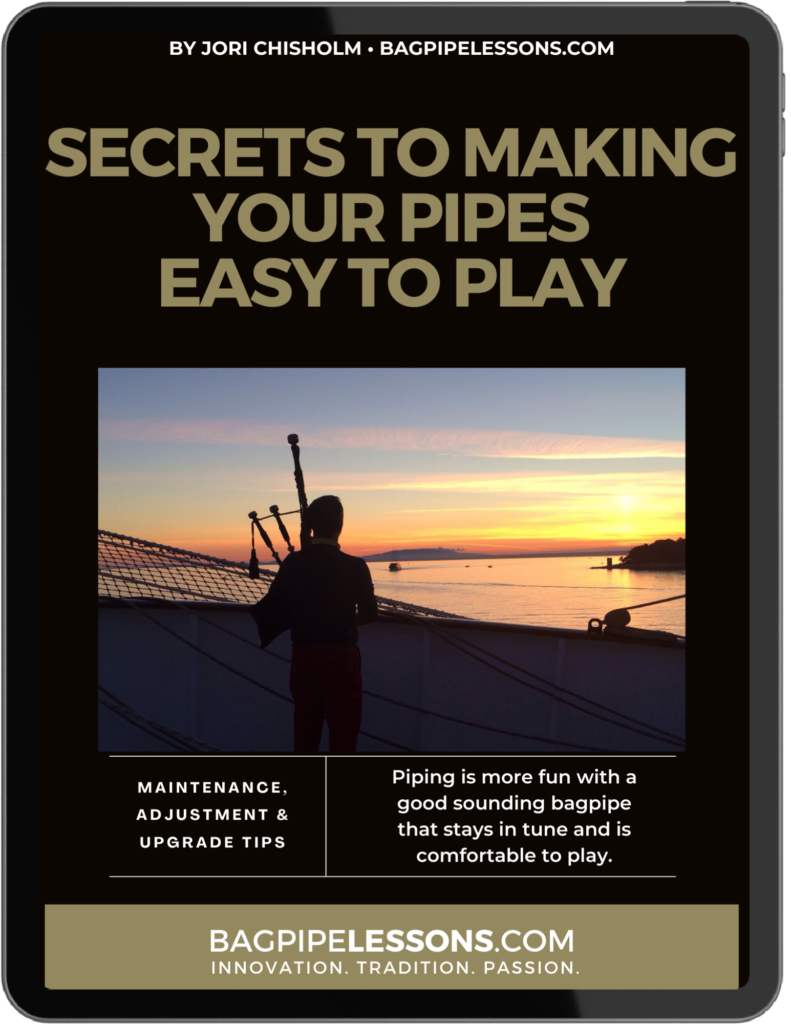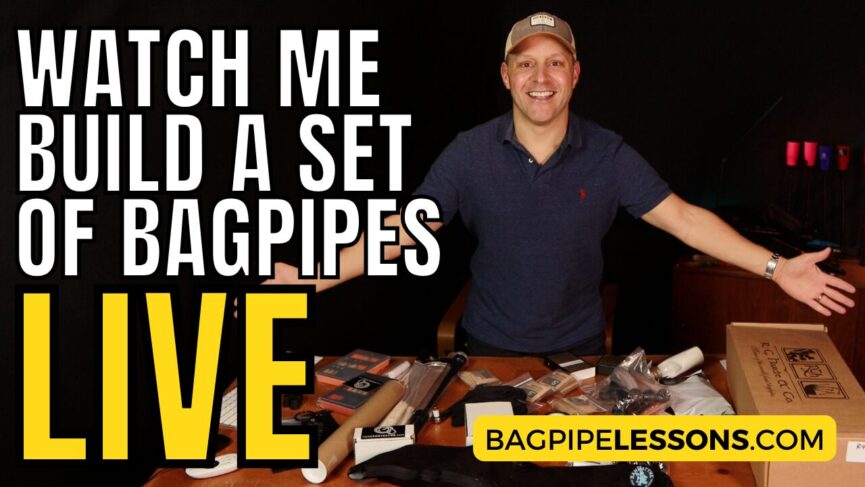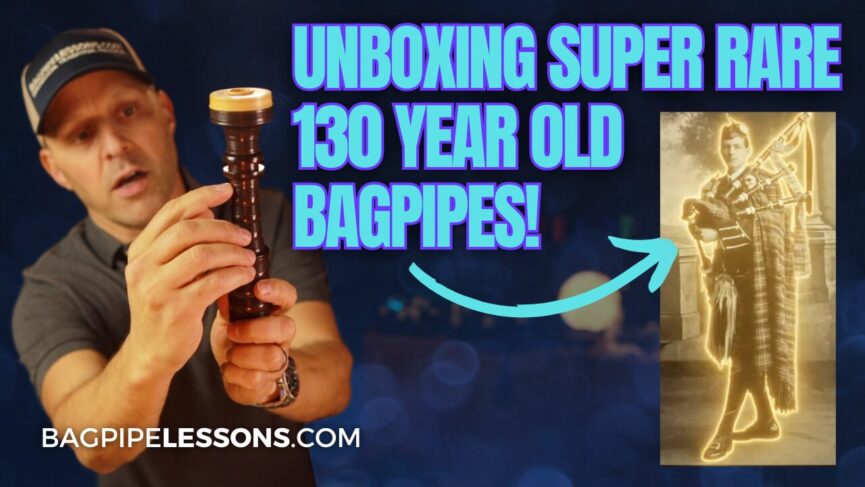
AS FEATURED IN

New 2025 Peter Henderson PH02 Bagpipes: Stealth Blackwood Mounts & Big Henderson Drone Sound
by Jori Chisholm, Founder of BagpipeLessons.com
Last Updated: September 25, 2025
I’m excited to share a close-up look and sound test of the new Peter Henderson PH02 bagpipes from R.G. Hardie. These are the same great new Hendersons as the PH01—laser-engraved nickel and the updated look—but with blackwood mounts instead of imitation ivory, giving a sleek, “stealth” aesthetic with the same rich Henderson drone sound and superb playability.
Products Mentioned in this Video:
- Peter Henderson Bagpipes
- Tone Protector™ Reed Case and Cap
- Bannatyne Hybrid Pipe Bag
- InTune Mic
- Driflo Moisture Control System
- Perfect Angle Blowpipe Positioner
Watch the video and scroll down to read the full video transcript.
What I cover in this video:
- Hear the PH02 in action—steady, efficient, and resonant.
- See the laser-engraved nickel (Thistle and Celtic options), slides, ferrules, caps, and the blackwood mounts up close.
- Learn the key difference between PH01 (imitation ivory) and PH02 (blackwood mounts).
- Get a quick tour of the setup I use: Bannatyne hybrid bag with bottom zip, DriFlo moisture control, Infinity pipe chanter, and Perfect Angle™ Blowpipe Positioner.
- Ordering options (sticks-only, complete, or premium bundle) and how to get your own set.
Video Transcript: Hey everybody, Jori Chisholm here from BagpipeLessons.com. Two months ago, I did an unboxing video on the channel of the brand-new Peter Henderson PH01 bagpipes, and since I put that video up, I’ve gotten so much interest in these new Peter Henderson bagpipes.
Today I’m going to show you a slightly different model, the PH02. But before we get into all the details, listen to how these pipes sound. Gosh, these are just totally amazing. What I want to do now is go into some detail and show you these great pipes.
They sound great, they feel really great to play, and they look really cool. You can go back on the channel after you’re done watching this video and find the unboxing video that I did in mid-July for these new Peter Henderson bagpipes.
I was in Scotland this summer, was at the factory, and was talking to Alastair Dunn. I got to take a tour of the shop. It was really, really cool to learn about these new offerings they have.
The PH01s have imitation ivory and the new laser-engraved nickel. The PH02 is exactly the same, but instead of the imitation ivory mounts, they have blackwood mounts. It has a very cool, kind of stealthy look to it.
I know some people really, really love this. It’s such a cool look. These are a set that I have just finished setting up for a student, so let’s just take a quick look.
So the PH01 in my other video—these are now the ones I’ve been playing—but they’ve mostly been taken over by my son, who’s learning to play, and he loves these pipes, and they sound really, really great.
They’ve got the new Heritage Blue and White cords and the new cover and stuff, so he’s really loving these. These have the thistle pattern—you can see the thistle pattern there. The PH02s, new for today’s video—I’m going to put these somewhere safely.
There they go. Everything is exactly the same, but they’ve replaced the imitation ivory with blackwood. So if you’re not into the ivory look, this would be the option for you. Again, it’s got the very cool thistle pattern.
Really, really nice. The laser-engraved ferrules (which are these rings), the slides, and also the caps on the top, and that little—what do you call that—bushing there—that is blackwood to match the mounts.
It also has a very cool blackwood blowpipe that is lined with plastic so it’ll never crack, and then this cool thistle-engraved nickel mouthpiece sleeve. Very, very cool. I also have these set up with my Perfect Angle Blowpipe Positioner. 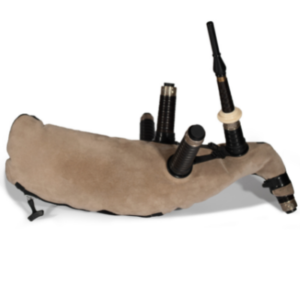
What that is: it’s this device here that attaches with O-rings to the bottom of your blowpipe stock, your bass drone stock, and your middle drone (middle tenor) stock. What that means is that when you’re playing, you can adjust these straps and buckles to get the blowpipe to sit right where you want it in the middle of your mouth.
Check this out: I let go of my mouth, and it just stays right there. Really, really cool. I wouldn’t ever want to play bagpipes without them. It’s got the small Bannatyne hybrid pipe bag with the bottom zipper, and it’s got the Driflo system on the inside.
Let me give you an up-close look here. Bagpipe makers offer different models of pipes, and with R.G. Hardie/Peter Henderson—that’s the same company; I think R.G. Hardie is the parent company—they make bagpipes in the R.G. Hardie range and in the Peter Henderson range. For these new Peter Henderson bagpipes, you can see there the PH01 with the imitation ivory and the PH02 with the blackwood mounts. It comes in three different styles of engraving.
It’s just a matter of personal preference. All this stuff is decorative anyway, but what your pipes look like is important. I really like this thistle engraving pattern. 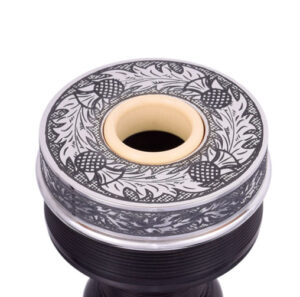
Let’s see if we can get that to focus—there you go. Thistle. A classic. There are different engraving patterns historically; there’s an infinite number because you can get custom engraving from some bagpipe makers.
I’d say this thistle pattern is pretty much an absolute classic. I just love that pattern. After the really enthusiastic response to my unboxing video from July, I ordered more of these.
First of all, I heard from tons of people: “I want to buy those; I want to get a set of those PH01s; I love the thistle engraving.” So I ordered some—actually had three orders right away from students who were looking for a great new set.
Then I ordered a couple of additional sets to have. They were all either the 01 with the imitation ivory or the 02 with the thistle, because people love the thistle—and I’m not going to argue with that.
I got this set by mistake—they sent me a Celtic pattern. I didn’t order this, but it is really, really cool. Check that out: it’s got a Celtic knot design, a really cool knot design on the side of the ring cap. 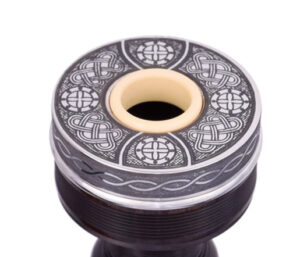
You can see some of this really nice Celtic knotwork there. Really, really cool. This is the new Peter Henderson PH02—“02” means it’s got the blackwood mounts—and this one has the Celtic engraving pattern.
Both of these sets are for sale, by the way. These are the last two sets I have that haven’t been spoken for. If you’re interested, get on right away: go to BagpipeLessons.com/
That will take you to a page where you’ll see the different bagpipes I have for sale on the site: the acetal ones (the plastic ones) or the Peter Henderson. Those are what you’re looking for.
Click on Peter Henderson. I’ll put all the links in the description below. PH01 (imitation ivory), PH02 (blackwood mounts). I have one set of this Celtic engraving—if you want it, you can get it.
You have the option of getting “sticks only.” “Sticks only” is literally a box with the sticks part of the bagpipe—three drones, the blowpipe, and five stocks. That’s what “sticks” is.
You can’t play that by itself because you still need a bag, a pipe chanter, and all the other stuff. So I sell it in three models. One is the sticks only, if you want to set it up yourself or if you already have some gear.
The other one is the basic model—that’s going to include the very basics you need to actually have an instrument you can play: a pipe chanter, a pipe chanter reed, the drone cords, and the bag.
That’s all installed for you. Then I have a premium package, which is extra reeds, Tone Protectors, Tone Protector Reed Cases, the InTune Mic, and everything—so check it out.
Go to BagpipeLessons.com/
I can’t believe that’s possibly true, but I’ve got two sets right here, and when these sell out, I’ll be ordering more. Check them out—just amazing sound. After I got the set that my son is playing now, I emailed Alastair Dunn and said, “How did you do it?”
“How did you get that amazing church-organ sound out of the drones?” He said they’ve been very, very true to the original Henderson design. If you talk to bagpipers who know the history of bagpipes or are obsessed with bagpipe sound, everybody knows the Henderson drone sound—the historic Henderson sound from over 100 years ago.
They’re doing it—they’re replicating that sound today with modern equipment and technology. When we were at the factory this summer, I got to see them do the laser engraving.
Every metal piece on these pipes is engraved individually. It’s not some mass-produced thing where they just put in a bunch of metal and it spits it out. Each piece is crafted individually, then placed into the laser engraver; they put down the little cover and you can look through the window, and this amazing green laser shoots out, turns it, and engraves it.
It’s really nice, and you can feel it—it’s a lot deeper than the laser engraving on some older models of pipes. What this technology means is you can get a world-class instrument at a great price.
It didn’t used to be like that. Some people still might think the best bagpipes are made by hand by a single person in a bespoke, old-world craftsman style.
I’d say that’s not true. These bagpipes are absolutely world-class. What this technology allows the bagpipe makers to do is replicate the design every time.
So it’s going to be exactly the same, perfectly made—whether it’s the laser engraving or the bores on the inside. It removes the element of difference you get when you’re eyeballing and doing things by hand.
A lot of really old bagpipes I’ve seen are beautiful and cool because they’re old, but they’re not that good—you can’t even swap parts because they’re different sizes.
So today you get the best of both worlds: very dedicated craftsmen, like we saw in the factory, using tools that allow a level of precision and consistency that you couldn’t get before.
And you have really top bagpipers who know what they’re doing and the sound they’re looking for, guiding the design and manufacturing process. At R.G. Hardie with these Peter Henderson pipes, it’s Alastair Dunn—double Gold Medallist, former Pipe Sergeant of Field Marshal Montgomery. He’s got all the credentials as a piper—soloist, competitor, band player, teacher—and he’s overseeing this. He’s got a great ear for sound. Then you have guys like Callum Beaumont and Connor Sinclair working and playing these bagpipes, testing them.
I know a little about the ins and outs of how this product-design process goes, and they never just rest and say, “This is it—the perfect design.” They’re always tweaking, coming up with something really good, and then trying to improve on it.
That relentless pursuit of perfection is what gets us to where we are now: amazing bagpipes. They look amazing, they sound amazing, and they feel great to play.
Really steady, super-efficient, and a great price. So check out BagpipeLessons.com/
We’ve got it in the thistle pattern or the Celtic pattern. There’s never been a better time to be a bagpiper in terms of access to information, community, connecting with pipers from around the world, and amazing high-quality bagpipes and other products that make it easier to play and get a great sound.
You can enjoy playing and you don’t have to be fussing around, worrying if your pipes are going to work from day to day. That’s all I’ve got for today. A bunch of links to everything is in the description below.
I’m going to shut off my camera, and these beautiful Peter Henderson PH02s with the Celtic blackwood mounts—I’m going to get out a bunch of bubble wrap, wrap these up, and send them to a happy piper who’s going to enjoy these pipes for a lifetime.
Thanks, everybody. Thanks for watching. If you like this video and want more,
Hey everybody, Jori Chisholm here from BagpipeLessons.com. Two months ago, I did an unboxing video on the channel of the brand-new Peter Henderson PH01 bagpipes, and since I put that video up, I’ve gotten so much interest in these new Peter Henderson bagpipes.
Today I’m going to show you a slightly different model, the PH02. But before we get into all the details, listen to how these pipes sound. Gosh, these are just totally amazing. What I want to do now is go into some detail and show you these great pipes.
They sound great, they feel really great to play, and they look really cool. You can go back on the channel after you’re done watching this video and find the unboxing video that I did in mid-July for these new Peter Henderson bagpipes.
I was in Scotland this summer, was at the factory, and was talking to Alastair Dunn. I got to take a tour of the shop. It was really, really cool to learn about these new offerings they have.
The PH01s have imitation ivory and the new laser-engraved nickel. The PH02 is exactly the same, but instead of the imitation ivory mounts, they have blackwood mounts. It has a very cool, kind of stealthy look to it.
I know some people really, really love this. It’s such a cool look. These are a set that I have just finished setting up for a student, so let’s just take a quick look.
So the PH01 in my other video—these are now the ones I’ve been playing—but they’ve mostly been taken over by my son, who’s learning to play, and he loves these pipes, and they sound really, really great.
They’ve got the new Heritage Blue and White cords and the new cover and stuff, so he’s really loving these. These have the thistle pattern—you can see the thistle pattern there. The PH02s, new for today’s video—I’m going to put these somewhere safely.
There they go. Everything is exactly the same, but they’ve replaced the imitation ivory with blackwood. So if you’re not into the ivory look, this would be the option for you. Again, it’s got the very cool thistle pattern.
Really, really nice. The laser-engraved ferrules (which are these rings), the slides, and also the caps on the top, and that little—what do you call that—bushing there—that is blackwood to match the mounts.
It also has a very cool blackwood blowpipe that is lined with plastic so it’ll never crack, and then this cool thistle-engraved nickel mouthpiece sleeve. Very, very cool. I also have these set up with my Perfect Angle blowpipe positioner.
What that is: it’s this device here that attaches with O-rings to the bottom of your blowpipe stock, your bass drone stock, and your middle drone (middle tenor) stock. What that means is that when you’re playing, you can adjust these straps and buckles to get the blowpipe to sit right where you want it in the middle of your mouth.
Check this out: I let go of my mouth, and it just stays right there. Really, really cool. I wouldn’t ever want to play bagpipes without them. It’s got the small Bannatyne hybrid pipe bag with the bottom zipper, and it’s got the Dryflow system on the inside.
Let me give you an up-close look here. Bagpipe makers offer different models of pipes, and with R.G. Hardie/Peter Henderson—that’s the same company; I think R.G. Hardie is the parent company—they make bagpipes in the R.G. Hardie range and in the Peter Henderson range. For these new Peter Henderson bagpipes, you can see there the PH01 with the imitation ivory and the PH02 with the blackwood mounts. It comes in three different styles of engraving.
It’s just a matter of personal preference. All this stuff is decorative anyway, but what your pipes look like is important. I really like this thistle engraving pattern.
Let’s see if we can get that to focus—there you go. Thistle. A classic. There are different engraving patterns historically; there’s an infinite number because you can get custom engraving from some bagpipe makers.
I’d say this thistle pattern is pretty much an absolute classic. I just love that pattern. After the really enthusiastic response to my unboxing video from July, I ordered more of these.
First of all, I heard from tons of people: “I want to buy those; I want to get a set of those PH01s; I love the thistle engraving.” So I ordered some—actually had three orders right away from students who were looking for a great new set.
Then I ordered a couple of additional sets to have. They were all either the 01 with the imitation ivory or the 02 with the thistle, because people love the thistle—and I’m not going to argue with that.
I got this set by mistake—they sent me a Celtic pattern. I didn’t order this, but it is really, really cool. Check that out: it’s got a Celtic knot design, a really cool knot design on the side of the ring cap.
You can see some of this really nice Celtic knotwork there. Really, really cool. This is the new Peter Henderson PH02—“02” means it’s got the blackwood mounts—and this one has the Celtic engraving pattern.
Both of these sets are for sale, by the way. These are the last two sets I have that haven’t been spoken for. If you’re interested, get on right away: go to BagpipeLessons.com/
That will take you to a page where you’ll see the different bagpipes I have for sale on the site: the acetal ones (the plastic ones) or the Peter Henderson. Those are what you’re looking for.
Click on Peter Henderson. I’ll put all the links in the description below. PH01 (imitation ivory), PH02 (blackwood mounts). I have one set of this Celtic engraving—if you want it, you can get it.
You have the option of getting “sticks only.” “Sticks only” is literally a box with the sticks part of the bagpipe—three drones, the blowpipe, and five stocks. That’s what “sticks” is.
You can’t play that by itself because you still need a bag, a pipe chanter, and all the other stuff. So I sell it in three models. One is the sticks only, if you want to set it up yourself or if you already have some gear.
The other one is the basic model—that’s going to include the very basics you need to actually have an instrument you can play: a pipe chanter, a pipe chanter reed, the drone cords, and the bag.
That’s all installed for you. Then I have a premium package, which is extra reeds, Tone Protectors, Tone Protector Reed Cases, the InTune Mic, and everything—so check it out.
Go to BagpipeLessons.com/
I can’t believe that’s possibly true, but I’ve got two sets right here, and when these sell out, I’ll be ordering more. Check them out—just amazing sound. After I got the set that my son is playing now, I emailed Alastair Dunn and said, “How did you do it?”
“How did you get that amazing church-organ sound out of the drones?” He said they’ve been very, very true to the original Henderson design. If you talk to bagpipers who know the history of bagpipes or are obsessed with bagpipe sound, everybody knows the Henderson drone sound—the historic Henderson sound from over 100 years ago.
They’re doing it—they’re replicating that sound today with modern equipment and technology. When we were at the factory this summer, I got to see them do the laser engraving.
Every metal piece on these pipes is engraved individually. It’s not some mass-produced thing where they just put in a bunch of metal and it spits it out. Each piece is crafted individually, then placed into the laser engraver; they put down the little cover and you can look through the window, and this amazing green laser shoots out, turns it, and engraves it.
It’s really nice, and you can feel it—it’s a lot deeper than the laser engraving on some older models of pipes. What this technology means is you can get a world-class instrument at a great price.
It didn’t used to be like that. Some people still might think the best bagpipes are made by hand by a single person in a bespoke, old-world craftsman style.
I’d say that’s not true. These bagpipes are absolutely world-class. What this technology allows the bagpipe makers to do is replicate the design every time.
So it’s going to be exactly the same, perfectly made—whether it’s the laser engraving or the bores on the inside. It removes the element of difference you get when you’re eyeballing and doing things by hand.
A lot of really old bagpipes I’ve seen are beautiful and cool because they’re old, but they’re not that good—you can’t even swap parts because they’re different sizes.
So today you get the best of both worlds: very dedicated craftsmen, like we saw in the factory, using tools that allow a level of precision and consistency that you couldn’t get before.
And you have really top bagpipers who know what they’re doing and the sound they’re looking for, guiding the design and manufacturing process. At R.G. Hardie with these Peter Henderson pipes, it’s Alastair Dunn—double Gold Medallist, former Pipe Sergeant of Field Marshal Montgomery. He’s got all the credentials as a piper—soloist, competitor, band player, teacher—and he’s overseeing this. He’s got a great ear for sound. Then you have guys like Callum Beaumont and Connor Sinclair working and playing these bagpipes, testing them.
I know a little about the ins and outs of how this product-design process goes, and they never just rest and say, “This is it—the perfect design.” They’re always tweaking, coming up with something really good, and then trying to improve on it.
That relentless pursuit of perfection is what gets us to where we are now: amazing bagpipes. They look amazing, they sound amazing, and they feel great to play.
Really steady, super-efficient, and a great price. So check out BagpipeLessons.com/
We’ve got it in the thistle pattern or the Celtic pattern. There’s never been a better time to be a bagpiper in terms of access to information, community, connecting with pipers from around the world, and amazing high-quality bagpipes and other products that make it easier to play and get a great sound.
You can enjoy playing and you don’t have to be fussing around, worrying if your pipes are going to work from day to day. That’s all I’ve got for today. A bunch of links to everything is in the description below.
I’m going to shut off my camera, and these beautiful Peter Henderson PH02s with the Celtic blackwood mounts—I’m going to get out a bunch of bubble wrap, wrap these up, and send them to a happy piper who’s going to enjoy these pipes for a lifetime.
Thanks, everybody. Thanks for watching. If you like this video and want more, hit the subscribe button on the YouTube channel. Hit the little bell so you get a notification. Go over to BagpipeLessons.com/learn.
I’ve got tons of free resources there and downloadable guides. I also have all the videos from my YouTube channel, on my Learn page; you can watch the videos there, and I’ve got all the transcripts if you want to read along.
Thanks for watching. I’m going to make more videos. Hope you’re doing well, and see you next time. Happy piping. Mahalo.
. Hit the little bell so you get a notification. Go over to BagpipeLessons.com/learn.
I’ve got tons of free resources there and downloadable guides. I also have all the videos from my YouTube channel on my Learn page; you can watch the videos there, and I’ve got all the transcripts if you want to read along.
Thanks for watching. I’m going to make more videos. Hope you’re doing well, and see you next time. Happy piping. Mahalo.
